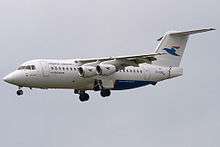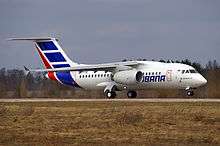Regional jet

A regional jet (RJ) is a class of short to medium-range turbofan powered regional airliners.
History
The term "regional jet" describes a range of short to medium-haul turbofan-powered aircraft, whose use throughout the world expanded after the advent of airline deregulation in the United States in 1978.
Regional jet airliners are not a new concept in aviation. Starting in the late 1960s Aeroflot, for example, used Yakolev Yak-40 regional sized mini-jet airliners, when its airline functioned as a state controlled national directive. In the West the smaller Aerospatiale Corvette was used as a regional airliner from the 1970s onwards. Several large business jets, such as the British Aerospace 125 and Dassault Falcon 20 were also operated by smaller airlines in the 1960s and 1970s.
Large 70–100 passenger short haul regional aircraft in the western world have existed for years. National "Flag carrier airlines" began ordering the first true purpose-built short-haul airliner, the Sud Aviation Caravelle, a twin turbojet airliner designed for use upon inter-European routes. To speed manufacturing, the Caravelle used the forward fuselage nose section of the de Havilland Comet, the West's first large-scale commercial jetliner, which was not as effective in continental-European flights.
Many of the post World War II airliners were often used on shorter and economically significant prestige routes such as London-Paris, or New York-Chicago, by the world's major airlines.
With the arrival of economy class travel, which blossomed during the post World War II years, non-jet aircraft of the larger airlines migrated toward the "trunk airlines," "minor airlines," "feeder airlines" and "commuter airlines" throughout international air lanes and sky ways.
In the post-war era many aircraft manufacturers sought to create a replacement aircraft for the "ubiquitous" Douglas DC-3, which was surplus in large amounts after the war. First with large 40–50 passenger sized piston powered Convair 340s and Martin 202s, and later with turboprop powered aircraft such as the Convair 580, Fairchild F-27 and Fokker F27
These earlier large 50 passenger aircraft had begun to trickle down to the larger trunk and minor airlines, which were used on shorter range regional routes that had become their forte, especially in the U.S. Smaller "mini-airliners" soon found niches regionally in the 1960s when aircraft manufacturers such as the British made Shorts Skyvan, Brazilian Embraer EMB 110 Bandeirante, and French Nord 262, all sought to capture the lower end of the DC-3 replacement market.
In the 1970s, the market for smaller sized mini-airliners boomed with the process of route liberalization in the U.S known as Airline Deregulation went into force in 1978. Airline passengers in the U.S accustomed to flying larger jet aircraft and even the smaller "trickled down" short haul propeller motivated and equipped "propliners", with features such as aircraft lavatories and air hostesses, were taken aback when flying aboard on "puddle jumpers" that had neither.
Due to growing markets for feeder routes, airlines and aircraft manufacturers rapidly replaced these "puddle jumpers" with larger amenity equipped, turboprop "mini airliners," generally flown by regionally based smaller airlines to feed larger airlines' hub cities. The same market forces also allowed these "mini airliners" to be rapidly supplanted by faster longer range, first generation turbofan powered regional jets (as the first generation Bombardier CRJ became known), differentiating them from prior generation equipment.
Another reason for the downturn in the turboprop market was the introduction of the first regional jets. Although a number of small jets entered service in the 1950s and 60s, notably the Sud Aviation Caravelle, Fokker F28 Fellowship, British Aircraft Corporation BAC One-Eleven and Yak-40, these could not compete in terms of cost of operation with the turboprop designs, and were suitable for routes with small numbers of passengers, as opposed to short routes where fuel economy was paramount. As engine technology improved, this difference continued to narrow, until the higher utilization factors due to higher cruising speeds erased any remaining advantage from lower operating costs.
The earliest example of a true short-range jet is the BAe 146, produced by BAE Systems. However, like the de Havilland Canada Dash 7 before it, the BAe 146 was tuned to a very specific market, city-center to city-center service where low noise and excellent takeoff performance were paramount. Like the Dash 7, the market niche for this design proved to be fairly small, and its four engines meant it had higher maintenance costs than twin-engine designs. Unlike the Dash 7 example BAe did not respond by producing a twin-engine design that filled the same range requirements but offering lower operational costs. The BAe 146 was produced in three differently sized versions, being the BAe 146-100, the BAe 146-200 and the largest example, the BAe 146-300. The aircraft would later be manufactured as the Avro Regional Jet (ARJ).
90's 50-seaters
.jpg)
Low fuel prices drove the development of the regional jet: in the '90s oil prices were around $10–20 per barrel. Turboprop manufacturers wanted to develop their portfolio. Canadair's purchase by Bombardier in 1986 enabled a stretched development of its Challenger business jet, green-lighted by then chief executive Laurent Beaudoin in March 1989. The first Bombardier four-abreast Canadair Regional Jet was delivered in October 1992 to Lufthansa CityLine.[1]
Embraer then developed the three-abreast ERJ 145 from the EMB-120 Brasilia turboprop, which was introduced in December 1996. They replaced the turboprops thanks to their better perceived image and larger range. On small-capacity long routes, they could offer a better service by increasing frequencies at a smaller capacity and could replace mainline jet airliners like McDonnell Douglas DC-9s and Boeing 737s.[1]
U.S. scope clauses
US major carriers high pilots' wages led them to subcontract flights to regional airlines with lower labour costs. Pilot unions then demanded to regulate subcontracted aircraft size to a 50 seats maximum scope clause. In turn, large routes were served by suboptimal 50-seat jets which accelerated demand for those types in North America. Embraer envisioned a market for more than 500 aircraft and planned to produce up to 80 a year, but at peak delivered 157 ERJs in 2000 while Bombardier delivered 155 CRJs in 2003.[1]
After 9/11, high fuel prices returned and jets had to grow to keep seat-mile costs down. Airlines renegotiated scope clause limits to 70-seat jets as the market consolidates. Larger aircraft came back on regional routes for their efficiency and on short routes turboprops don't lose too much time for a lower cost, reversing the 90's trend. Bombardier delivered its last 50-seat CRJ in 2006 and Embraer its last ERJ in 2011.[1]
Larger jets
Bombardier switched to its lengthened 70- to 100-seat CRJ700/900/1000, while Embraer launched the four-abreast E-Jet170/175/190/195. 50 seats jets demand is lower with high fuel prices, and it reflects on a lower market value. A majority of them will be scrapped.[1]
Bombardier and Embraer have been locked in a series of counter-lawsuits over export taxes and subsidies ever since. The ERJ's success led to a totally new version, the Embraer E-Jets series. Bombardier developed a larger aircraft in response, the CSeries.

These aircraft were originally intended to be used for direct airport-to-airport flights, bypassing hubs, and led to industry-wide discussions about the decline of the hub-and-spoke model. Although not as economical as the turboprop, by flying directly to and from smaller airports, they reduced the need for low-cost regional airliners. And although turboprops are quiet to outside observers, propwash makes them very noisy inside.[2] Passengers greatly preferred jets, both for real and perception reasons.
Other competitors have not been successful. Fairchild Dornier introduced the Fairchild Dornier 328JET to compete, but went bankrupt soon afterwards and the type did not enter large scale production. Their bankruptcy also ended development of the more competitive Fairchild-Dornier 728, which had attracted strong airline interest. The CRJ/ERJ also resulted in the end of the BAe 146 line.
The CRJ and ERJ success also played a minor part in the failure of Fokker, whose Fokker 100 found itself squeezed on both sides by new models of the Boeing 737 and Airbus A319 on the "large" side and the RJs on the "small side". Bombardier turned down the chance to purchase Fokker's assets, feeling that the 100-seat market was already saturated by designs like the A319, a decision that looked foolish with the successful introduction of the E-Jets.
The Antonov An-148 has been successfully certified and tested and the production has started with three machines already built. Most of the orders are from post-Soviet markets and the Middle East, for European markets are still fairly hesitant to adopt aircraft from the former Soviet Union. The Sukhoi Superjet 100, a 60 to 95-seat jet developed by the Russian aerospace firm Sukhoi with assistance of Ilyushin and Boeing, completed its maiden flight in May 2008.
The largest regional jet to date was the Boeing 747-Short Range (SR), used extensively in Japan. The aircraft had a strengthened undercarriage and airframe to cope with the additional landings and takeoffs regional flights make. Japan Air Lines was the first airline in the world to introduce this 747 version, in 1974. Coincidently it was this short-range Boeing 747 version that was involved in the horrifying loss of life in the crash of Japan Airlines Flight 123 and the most loss of life upon a jetliner of any size.
See also
References
- 1 2 3 4 5 "Boom and bust, the regional jet phenomenon". Flight Global. 10 April 2012.
- ↑ "Airlines give propellers another spin". MSNBC. Retrieved 2008-05-01.
External links
- "Comair Turns 30 Airline's Early Days Humble". RedOrbit.com. July 16, 2007.
- "Passenger aircraft : Yak-40". Yakovlev Design Bureau.
- "The 50-Seat Jet: A Plane With No Future. Think again!" (PDF). Oliver Wyman. 2010.






